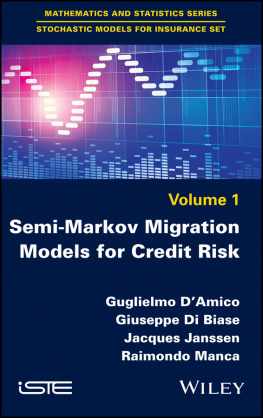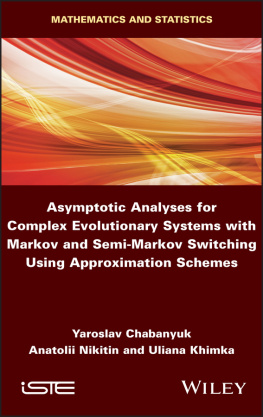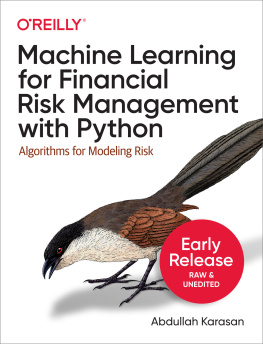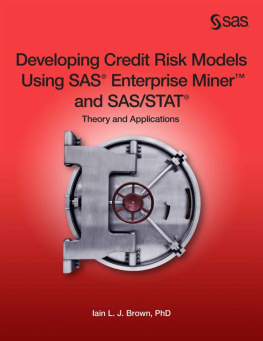Janssen Jacques - Semi-Markov Migration Models for Credit Risk
Here you can read online Janssen Jacques - Semi-Markov Migration Models for Credit Risk full text of the book (entire story) in english for free. Download pdf and epub, get meaning, cover and reviews about this ebook. year: 2017, publisher: John Wiley & Sons, Incorporated, genre: Computer. Description of the work, (preface) as well as reviews are available. Best literature library LitArk.com created for fans of good reading and offers a wide selection of genres:
Romance novel
Science fiction
Adventure
Detective
Science
History
Home and family
Prose
Art
Politics
Computer
Non-fiction
Religion
Business
Children
Humor
Choose a favorite category and find really read worthwhile books. Enjoy immersion in the world of imagination, feel the emotions of the characters or learn something new for yourself, make an fascinating discovery.
- Book:Semi-Markov Migration Models for Credit Risk
- Author:
- Publisher:John Wiley & Sons, Incorporated
- Genre:
- Year:2017
- Rating:3 / 5
- Favourites:Add to favourites
- Your mark:
- 60
- 1
- 2
- 3
- 4
- 5
Semi-Markov Migration Models for Credit Risk: summary, description and annotation
We offer to read an annotation, description, summary or preface (depends on what the author of the book "Semi-Markov Migration Models for Credit Risk" wrote himself). If you haven't found the necessary information about the book — write in the comments, we will try to find it.
Semi-Markov Migration Models for Credit Risk — read online for free the complete book (whole text) full work
Below is the text of the book, divided by pages. System saving the place of the last page read, allows you to conveniently read the book "Semi-Markov Migration Models for Credit Risk" online for free, without having to search again every time where you left off. Put a bookmark, and you can go to the page where you finished reading at any time.
Font size:
Interval:
Bookmark:

Stochastic Models for Insurance Set
coordinated by
Jacques Janssen
Volume 1
Guglielmo DAmico
Giuseppe Di Biase
Jacques Janssen
Raimondo Manca

First published 2017 in Great Britain and the United States by ISTE Ltd and John Wiley & Sons, Inc.
Apart from any fair dealing for the purposes of research or private study, or criticism or review, as permitted under the Copyright, Designs and Patents Act 1988, this publication may only be reproduced, stored or transmitted, in any form or by any means, with the prior permission in writing of the publishers, or in the case of reprographic reproduction in accordance with the terms and licenses issued by the CLA. Enquiries concerning reproduction outside these terms should be sent to the publishers at the undermentioned address:
ISTE Ltd
27-37 St Georges Road
London SW19 4EU
UK
www.iste.co.uk
John Wiley & Sons, Inc.
111 River Street
Hoboken, NJ 07030
USA
www.wiley.com
ISTE Ltd 2017
The rights of Guglielmo DAmico, Giuseppe Di Biase, Jacques Janssen and Raimondo Manca to be identified as the authors of this work have been asserted by them in accordance with the Copyright, Designs and Patents Act 1988.
Library of Congress Control Number: 2017931483
British Library Cataloguing-in-Publication Data
A CIP record for this book is available from the British Library
ISBN 978-1-84821-905-2
- 1 Semi-Markov Processes Migration Credit Risk Models
- 3 Recurrence Time Credit Risk Applications
- 4 Mono-Unireducible Markov and Semi-Markov Processes
- 5 Non-Homogeneous Semi-Markov Reward Processes and Credit Spread Computation
- 6 NHSMP Model for the Evaluation of Credit Default Swaps
- 7 Bivariate Semi-Markov Processes and Related Reward Processes for Counterparty Credit Risk and Credit Spreads
- 8 Semi-Markov Credit Risk Simulation Models
- 1 Semi-Markov Processes Migration Credit Risk Models
- 2 Recurrence Time HSMP and NHSMP: Credit Risk Applications
- 3 Recurrence Time Credit Risk Applications
- 4 Mono-Unireducible Markov and Semi-Markov Processes
- 5 Non-Homogeneous Semi-Markov Reward Processes and Credit Spread Computation
- 7 Bivariate Semi-Markov Processes and Related Reward Processes for Counterparty Credit Risk and Credit Spreads
- 8 Semi-Markov Credit Risk Simulation Models
This book is a summary of several papers that the authors wrote on credit risk starting from 2003 to 2016.
Credit risk problem is one of the most important contemporary problems that has been developed in the financial literature. The basic idea of our approach is to consider the credit risk of a company like a reliability evaluation of the company that issues a bond to reimburse its debt.
Considering that semi-Markov processes (SMPs) were applied in the engineering field for the study of reliability of complex mechanical systems, we decided to apply this process and develop it for the study of credit risk evaluation.
Our first paper [DAM 05] was presented at the 27th Congress AMASES held in Cagliari, 2003. The second paper [DAM 06] was presented at IWAP 2004 Athens. The third paper [DAM 11] was presented at QMF 2004 Sidney. Our remaining research articles are as follows: [DAM 07, DAM 08a, DAM 08b, SIL08, DAM 09, DAM 10, DAM 11a, DAM 11b, DAM 12, DAM 14a, DAM 14b, DAM 15, DAM 16a] and [DAM 16b].
Other credit risk studies in a semi-Markov setting were from [VAS 06, VAS 13] and [VAS 13]. We should also outline that up to now, at authors knowledge, no papers were written for outline problems or criticisms to the applications of SMPs to the migration credit risk.
The study of credit risk began with so-called structural form models (SFM). Merton [MER 74] proposed the first paper regarding this approach. This paper was an application of the seminal papers by Black and Scholes [BLA 73]. According to Mertons paper, default can only happen at the maturity date of the debt. Many criticisms were made on this approach. Indeed, it was supposed that there are no transaction costs, no taxes and that the assets are perfectly divisible. Furthermore, the short sales of assets are allowed. Finally, it is supposed that the time evolution of the firms value follows a diffusion process (see [BEN 05]).
In Mertons paper [MER 74], the stochastic differential equation was the same that could be used for the pricing of a European option. This problem was solved by Black and Cox [BLA 76] by extending Mertons model, which allowed the default to occur at any time and not only at the maturity of the bond. In this book, techniques useful for the pricing of American type options are discussed.
Many other papers generalized the Merton and Black and Cox results. We recall the following papers: [DUA 94, LON 95, LEL 94, LEL 06, JON 84, OGD 87, LYD 00, EOM 03] and [GES 77].
The second approach to the study of credit risk involves reduced form models (RFMs). In this case, pricing and hedging are evaluated by public data, which are fully observable by everybody. In SFM, the data used for the evaluation of risk are known only within the company. More precisely, [JAR 04] explains that in the case of RFM, the information set is observed by the market, and in the case of SFM, the information set is known only inside the company.
The first RFM was given in [JAR 92]. In the late 1990s, these models developed. The seminal paper [JAR 97] introduced Markov models for following the evolution of rating. Starting from this paper, although many models make use of Markov chains, the problem of the poorly fitting Markov processes in the credit risk environment has been outlined.
Ratings change with time and a way of following their evolution their by means of Markov processes (see, for example, [JAR 97, ISR 01, HU 02]. In this environment, Markov models are called migration models. The problem of poorly fitting Markov processes in the credit risk environment has been outlined in some papers, including [ALT 98, CAR 94] and [LAN 02].
These problems include the following:
- the duration inside a state: actually, the probability of changing rating depends on the time that a firm remains in the same rating. Under the Markov assumption, this probability depends only on the rank at the previous transition;
- the dependence of the rating evaluation from the epoch of the assessment: this means that, in general, the rating evaluation depends on when it is done and, in particular, on the business cycle;
- the dependence of the new rating from all history of the firms rank evolution, not only from the last evaluation: actually, the effect exists only in the downward cases but not in the case of upward ratings in the sense that if a firm gets a lower rating (for almost all rating classes), then there is a higher probability that the next rating will be lower than the preceding one.
All these problems were solved by means of models that applied the SMPs, generalizing the Markov migration models.
This book is self-contained and is divided into nine chapters.
The first part of the briefly describes the rating evolution and introduces to the meaning of migration and the importance of the evaluation of the probability of default for a company that issues bonds. In the second part, Markov chains are described as a mathematical tool useful for rating migration modeling. The subsequent step shows how rating migration models can be constructed by means of Markov processes.
Next pageFont size:
Interval:
Bookmark:
Similar books «Semi-Markov Migration Models for Credit Risk»
Look at similar books to Semi-Markov Migration Models for Credit Risk. We have selected literature similar in name and meaning in the hope of providing readers with more options to find new, interesting, not yet read works.
Discussion, reviews of the book Semi-Markov Migration Models for Credit Risk and just readers' own opinions. Leave your comments, write what you think about the work, its meaning or the main characters. Specify what exactly you liked and what you didn't like, and why you think so.








